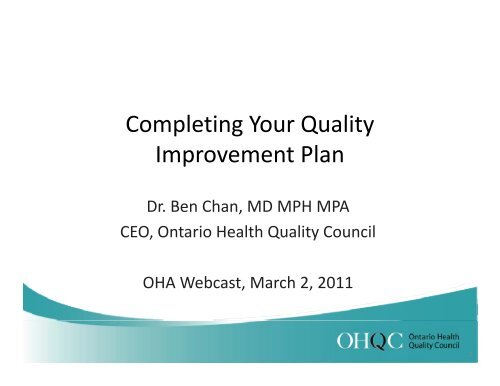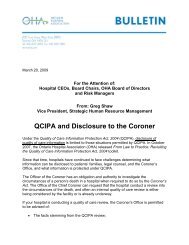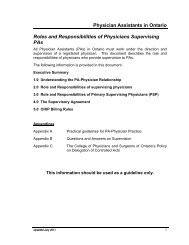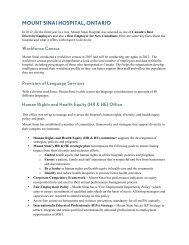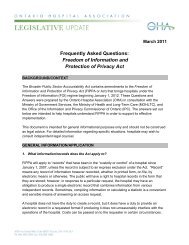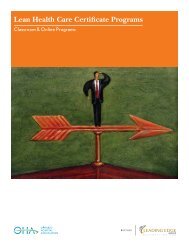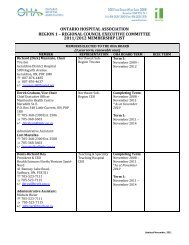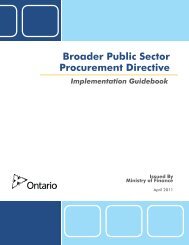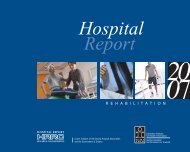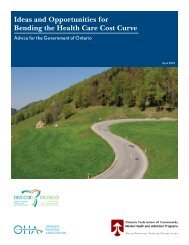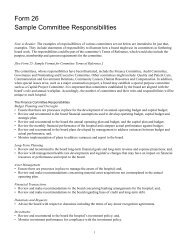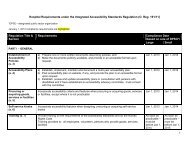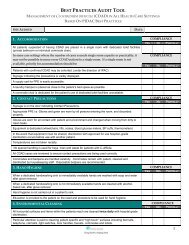Completing Yo r Q alit Completing Your Quality Improvement Plan
Completing Yo r Q alit Completing Your Quality Improvement Plan
Completing Yo r Q alit Completing Your Quality Improvement Plan
Create successful ePaper yourself
Turn your PDF publications into a flip-book with our unique Google optimized e-Paper software.
<strong>Completing</strong> <strong>Yo</strong>ur Qu<strong>alit</strong>y<strong>Improvement</strong> <strong>Plan</strong>Dr. Ben Chan, MD MPH MPACEO, Ontario Health Qu<strong>alit</strong>y CouncilOHA Webcast, March 2, 20111
Indicators for QI <strong>Plan</strong>• “core” indicators in QI <strong>Plan</strong>– Purpose: promote comparability betweenhospitals– Aligned with provincial priorities• Organizations still encouraged to includeindicators for local priorities3
What are Required Indicators?• For acute care hospitals:• At least one of: C Diff, VAP, hand hygiene, CLI, new ulcers in CCC, falls in CCC,• HSMR (if large enough to publicly report on it)• Readmissions• ALC• Total margin• ED wait times (either admitted pts or complex pts)– For urgent care centres, include if publicly reporting wait times• % who would definitely recommend to others– Specify if for hospital or ED• No obligation to set any of the above at priority 1• Indicators to be tied idto exec compensation are not specified inlegislation—hospitals to make this determination• If area already optimized (e.g. VAP=0), consider setting goal tomaintain at that level4
What Are Required Indicators?• For mental health hospitals:– Safety –not required to include any of the coresafety indicators in the template• please include other safety indicator that is relevant toyour organization– Not required to include HSMR– Do not include ED waits if no ED• please include other access indicator5
Statistical Variation in Measures• Random variation in all measures• Greater variability if:– Rare event– Smaller hospital– Small sample size• Can lead to difficulty in making determinationthat a true improvement took place6
Approach to Statistical Variation• Step 1: consider target for an indicator• Step 2: calculate l % improvement anticipatedi t • Step 3: examine (using simple guidelines in next slides, orformal statistical tests) whether this level of improvementcould be detected statistically• Step 4: if it cannot, consider the following options:– Consider a more ambitious target– Consider making this a multi‐year target instead; do not tie exec compto indicator this year– Consider other indicators for the same problem, with more frequentobservations or greater ability to make large change– Base the baseline on longer time period (e.g. past 2 yrs)– Collect more data (e.g. more surveys)7
Rare EventsIf you had a bad eventThe number of bad events would havethat occurred thefollowing number oftimes last year...to drop to this level in the coming yearbefore you could say you've made astatistically significant drop% Drop5 0 100%10 3 70%25 13 48%50 32 36%75 53 29%100 74 26%200 163 19%Assumes Poisson distribution of rare events.8
HSMRIf difference between the the HSMR would have to dropupper and lower confidencethis amount in one year beforeinterval for HSMR in a typicalyear is:you could say you had astatistically significant change:8 5.510 712 8.514 1016 11.518 12.520 149
Patient Experience SurveyThis coming year's score would have toreach this level before you could sayyou’ve made a statistically significantimprovement:If last year's score was:if collect 100surveys / yr)if 300surveys / yr50% 64% 58% 54%60% 73% 68% 64%70% 82% 77% 74%80% 90% 86% 83%if 1000surveys / yrAssuming same sample size each year.10
More Advanced Analyses• Run chart & run chart rules• Statistical process control charts• Oh Other statistical i tests (e.g. Chi‐sq for trend)11
Seasonal Variation• Some indicators fluctuate during the year• E.g. Busy ED at Christmas, flu season, March break• Options for dealing with seasonal variation:– Ensure same‐quarter comparisons• Eg E.g. Compare 2010‐1111 Q4 with 2011‐1212 Q4; do notcompare 2010‐11 Q3 to 2011‐12 Q4– Use four‐quarter or 12‐month rolling gaeages averages• E.g. ok to compare Dec09‐Nov10 to Apr11‐Mar1212
Example:• Foxden Regional Hospital wants to reduce inpatientfalls. It is very worried about falls withinjury, but that number is rather low (10 peryear). There are about 80 falls per year. Itbelieves it can reduce falls by 30%.• Which h measure should ldit use, and would it beable to detect this degree of change?13
Rare EventsIf you had a bad eventThe number of bad events would havethat occurred thefollowing number oftimes last year...to drop to this level in the coming yearbefore you could say you've made astatistically significant drop% Drop5 0 100%10 3 70%25 13 48%50 32 36%75 53 29%100 74 26%200 163 19%Assumes Poisson distribution of rare events.14
Example ‐ Answer• Foxden is better off using # of in‐patient fallsfor its plan• 30% improvement represents significantchange• Foxden can still choose to monitor falls fll with ihinjury (especially over long‐term)15
Ideas for <strong>Improvement</strong>:Change Section of Template• Consider:– What are the best practices to optimize?– How will I measure whether or not these practiceshave been optimized?– What does successful implementation of bestpractices look like (in measurable terms?)16
Distinction Between“Targets” and “Goals”• Goals: what an organization aspires toachieve• Hospitals encouraged to set “stretch goals”• does not need to be tied to exec compensation• Target: a specific goal which is also tied toexec compensation• For this year, may wish to focus on specific outcomes orprocesses which are more within direct control ofexecutive team17
Example• Our plan: improving the patient experience isa key priority. We will improve the % ofpatients who would definitely recommend usto family & friends from 65% (below average)to 80% (a leader) over the next three years.• To do this, our specific focus this year is paincontrol. We’ll hold our executives accountablefor improving this.18
Template: Line‐by‐Line Style<strong>Improvement</strong>InitiativeCurrentperf.Perf.goal PriorityRecommend tofi friends, family? 70% 73% 2<strong>Improvement</strong>initiativepaindocumentationfor all med / surgptsMethods and results trackingTarget2011/12chart audit of med/surg patients:% with daily visual analogue painscale documented 90%TargetjustificationRecognizedbest practice% who saidstaff dideverything theycould to controlpain 70% 75% 1chart audit of palliative/selectedPt controlledanalgesia forsurgery patients: % documentedto be in pain and did not get PCApalliative, selected and no documentedsurgery patients contraindication
Template: Line‐by‐Line Style<strong>Improvement</strong>InitiativeCurrentperf.Perf.goal PriorityRecommend tofi friends, family? 70% 73% 2<strong>Improvement</strong>initiativeOverall paininitiativepaindocumentationfor all med / surgptsMethods and results trackingTarget2011/12% who said staff did everythingthey could to control pain 75%chart audit of med/surg patients:% with daily visual analogue painscale documented 90%TargetjustificationAim to bebetter thanaverageRecognizedbest practice% who saidstaff dideverything theycould to controlpain 70% 75% 1chart audit of palliative/selectedPt controlled surgery patients: % documentedanalgesia for to be in pain and did not get PCApalliative, selected and no documentedRecognizedsurgery patients contraindication
Template: Cascade Style<strong>Improvement</strong>InitiativeWould yourecommendthis hospitalto yourfriends andfamily?Current Perf. <strong>Improvement</strong>Target Targetperf.goal Priorityinitiative Methods and results tracking2011/12justification70% 73% 1 Pain controlPicker survey: increase % who Aim to besaid we did everything webetter thancould to control pain from 70% 75% averagechart audit of med/surgpatients: % with daily visualanalogue pain scaledocumented 90%Recognizedbest practicechart audit of palliative,selected surg patients: %documented to be in pain anddid not get pt‐controlledanalgesia and no documentedcontraindication
“<strong>Improvement</strong> Initiative”• Option 1: Clinical best practice approach– Outline the specific evidence‐based clinical bestpractices, and set target for compliance with eachpractice.• Option 2: organizational practices approach– Outline specific methods you will use to ensurefull adoption of best practices• E.g. Intensive audit and feedback; LEAN processredesign22
• Likely already done:Hand Hygiene– Staff education campaigns– Hand‐washing stations• Other ideas?– More frequent audit & posting of results– Ask patients to ask staff if they’ve washed hands– Ensure hand‐washing stations never empty– “Positive deviant” approach• Identify individuals who wash hands without fail; identify behaviours,strategies of these individuals; construct activities for others to learnthese behaviours23
Falls• Hospitals tracking falls in complex continuing careshould use “% of residents who fell in the last 30 days”– a change from the original guidance document and template– Readily available to hospitals from CCRS• To calculate baseline, average data from the four mostrecent fiscal quarters24
Falls – Change Ideas• ↓ or eliminate use of bedrails and restraints (canparadoxically lead to more falls)• Use beds lower to ground with mats to cushion a potential fall• ↓ use of drugs that increase risk of falls (e.g.benzodiazepines)• Ensure proper foot wear used consistently• Improve consistent use of assistive devices (e.g. walkers)• Physiotherapy to increase lower body strength and balance,for selected individuals• prompted voiding protocols to ↓inconnence– prevent individual d getting up to void if can’t wait for help hl25
VAP, CLI– Follow BundlesVAP:• Head of bed up (30 ⁰, ideal 45⁰)• Daily spont. breathing trial (see ifcan extubate)• Appropriate level lof sedation &daily “sedation vacation”• Oral instead of nasal gastricdrainage tube• Oral ETT with port for continuousaspiration of subglotticsecretions (CASS)• Oral care protocol withchlorhexidine• General: PUD&DVT prophylaxis,nutrition, hand hygieneCLI:• Hand hygiene• Full barrier precautions• Chlorhexidine skin antisepsis• “Scrub the hub”• Daily review of need for line• Dedicated lumen for TPN• Check inflammation at each dressingchange26
VAP, CLI• If VAP, CLI persist in your hospital, why?– Regular tracking of process measures?• Which part of bundle not being executed flawlessly?Why?– Protocols, standard orders in place?– Skills of all staff verified?• Agency staff? New hires? Trainees/residents?27
• Special considerations:C Difficile– Switch from the less sensitive EIA (ELISA immunoassay) to the moresensitive two‐stage test involving GHB and PCR– If hospital switching methods, C difficile rates will appear to jumpupwards even if infection control practices did not change– If so, consider options:• Don’t include in this year’s QI plan• Include but do not tie to exec comp• Add caveat in comments section28
Pressure Ulcers ‐ CCC• Use CCRS indicator “% of residents who had a newstage 2 – 4 pressure ulcer” , with baseline based onan average of the four most recent fiscal quarters• Best practices:– Use of risk scoring– pressure‐relieving mattresses, padding if high risk– Turning q2 hrs if immobile– Transfer technique (do not shear skin)– Train staff to detect stage 1 earlier– Optimize nutrition, avoid incontinence29
ALC, ED waits, Readmissions• Three areas where improvement depends onchanges within hospital and in home care,primary care, LTC• Consider working with LHINs to developregional plans and performance goals30
Readmissions• Ideas for improvement within hospital control:– Timely discharge summaries– Use of risk score for readmission (e.g. LACE tool)– Documented FP follow‐up visit (with confirmedappointment time) within 5 days for high‐risk pts– Document confirmation of day‐after‐dischargehome care visit arranged for high‐risk pts– Written discharge instructions and “teach‐back”31
HSMR• Possible goals: reduction 5 to 10 points per year• Ideas to consider under improvement initiatives(change ideas section):– Sepsis management– Rapid response team– Optimize AMI care bundle– Optimize CHF care bundle– Optimize stroke care bundle– VTE prophylaxis32
Patient Experience• All hospitals that use NRC‐Picker are requested to include agoal for the global indicator “% who would definitelyrecommend this hospital to family or friends”• In order to make any progress in this global indicator,hospitals should pick specific ideas for improvement, such chas:– Discharge Transitions– Pain Control– Responsiveness to Concerns– Communication– Courtesy and Respect• Select indicator based either on standard index or specific surveyquestions33
Patient Experience ‐ Data• Current challenges with Picker survey:– Turnaround time for most recent results 3‐5 months– Standard reports come only every quarter– Sampling frame often makes it difficult to trackimprovements in a ward where ideas being tested– the number of surveys collected per month may be toosmall to detect early improvement34
Patient Experience –Data for Qu<strong>alit</strong>y <strong>Improvement</strong>• OHQC recommends mini‐surveys:– Select a small number of questions from the NRC‐Picker survey thatreflect areas for improvement tin the plan– Create a mini‐survey by putting these survey questions on a single orhalf‐sheet of paper– distribute to patients just before discharge– Let patients deposit anonymously (e.g. into box with a slit)– Run continuously during an improvement process, on units wheretrying new ideas• Use to monitor whether intended changes moving qu<strong>alit</strong>y inthe right direction, feed PDSA cycles35
Setting Performance Goals and Targets• Consider best practice in Ontario or worldwide• VAP, CLI rate 0 (Ontario, international examples)• C diff. rates of ~ .15 (some hospitals in Ontario)• % definitely recommend at 80‐90% among leaders inUSA; 70% average in Ontario• Surgical waits: 100% within target for all surgeries forall priority levels (North <strong>Yo</strong>rk General)• Consider decreasing gap from current to best by half• Consider pace of improvement seen elsewhere• E.g. decrease in HSMR of 5‐10 points / yr
Performance Goals, Targets• ED length of stay: official provincial target is 8 hours• most small & medium volume hospitals within the provincial target, butcould still improve• current provincial average 11.6 hrs; some large hospitals > 20 hrs• Hospitals with the best results include:– Pediatric hospitals, CHEO (7.5 hours)– Teaching hospitals, Thunder Bay Regional (10.7), Mt Sinai (11.3 hours)– Very‐high h volume community hospitals, Oakville‐Trafalgar l (6.5 hours),Orillia –Soldiers memorial (6.6), Windsor‐Grace (8.9), Queensway‐Carleton (9.7), Windsor‐Metropolitan (9.8), St. Joseph’s–Toronto (10).– Mdi Medium volume community hospitals, Hldi Haldimand dWar Memorial l(3.2),Carleton Place (4.5), Perth and Smith Falls District (5.1)– High volume community hospitals, Georgetown (4.9), Orangeville(6.1), Owen Sound d(6.4)37
Part A– Overview• Provide plain language g description of QI plan• Can be used to share with public, patient advisory groups, orto communicate plan to staff & get them excited about it• Brief – maximum 1 – 2 pages• Components:– Overview (~100 words)– Focus, and how objectives and initiatives will be achieved• Aims, change ideas– Alignment– Challenges, Risks & Mitigating Strategies38
Sample: Part A ‐ Overview“Shewhart will be one of the safest teaching hospitals in Ontario.We will relentlessly pursue perfection, by aiming to eliminatecertain hospital‐acquired infections and other avoidablecomplications, and ensuring patients get the right drugs,treatment and monitoring all the time. We will drive ourmort<strong>alit</strong>y rate down by 5% per year for the next four years.Patients with complex needs will wait one hour less by next year,as we focus on safe and timely hand‐offs in care. Our patientswill be confident in our safety practices and have among thehighest rates of satisfaction in the province.”39
Part A ‐What the organization will be focusing on andhow these objectives and initiatives will be achieved• Aims & Measures ‐ By March 31st 2012, we will:• Reduce overall hospital mort<strong>alit</strong>y by 5% as measured by HSMR, andcontinue 5% reductions per year over the subsequent three years• Hold gains on certain infections (ventilator‐associated pneumonia andcentral line infection at zero)• Attain 90% compliance on hand hygiene, and be in the top 10% for Cdifficile infection rates (0.15 per 1000 bed‐days) y)• For heart attack care, sepsis and prevention of blood clots: increasecompliance from 70% to 90% on adherence for best practices (i.e. gettingthe right drug, test or treatment at the right time).40
Part A ‐What the organization will be focusing on andhow these objectives and initiatives will be achievedAims & Measures ‐ By March h31st 2012, we will:• Reduce emergency department wait times by one hour, from16 to 15 (as measured by maximum time spent in ED for 9 of10 patients with complex needs)• Reduce the percent of beds that are ALC (alternate level ofcare) from 21% to 19%• Reduce readmissions by 5% for selected conditions• Have 73% of our patients say they would “definitely”i recommend our hospital to others (increase from 70%; this ispart of a three year plan to increase this to 80%).41
Part A ‐ Ideas for <strong>Improvement</strong>From April 2011 to March 2012, we will:• Continue to monitor adherence to practice guidelines for ventilatorassociatedpneumonia and central line infection.• Use physician champions to promote hand hygiene among staff.Encourage patients to ask staff if they’ve washed their hands yet. Monitorcompliance monthly and post results on each ward.• Update our clinical information system so that we can track compliance on25 key clinical best practices for heart attack, sepsis and VTE prophylaxisand feed information on individual physician performance back tophysicians.• Enhance the medication reconciliation process and ensure all patientsleave knowing, for each drug, the dosage, purpose, and changes made tomedications while in hospital.42
Ideas for <strong>Improvement</strong> cont.From April 2011 to March 2012, we will:• Enhance the medication reconciliation process and ensure all patientsleave knowing, for each drug, the dosage, purpose, and changes made tomedications while in hospital.• Use database‐driven discharge summaries to eliminate delays in sendingout discharge summaries.• Implement LEAN to reduce turn‐around times for lab and diagnosticimaging• Update our bed tracking system in the ED and hospital to ensure beds aremade available as soon as possible after they are vacated• Train 10 additional staff on LEAN process improvement at the green‐beltlevel43
How the plan aligns with the other planningprocesses? (e.g. H‐SAA, Accreditation, LHIN)“If we are successful at our targets for readmissions, ED and ALC, we will fulfillour obligations for our hospital service agreement and our participation in theMinistry’s ED pay‐for‐results program. Work on infection control, medicationreconciliation and venous thromboembolism is consistent with requiredoperating procedures for accreditation. The ED and ALC targets are alsodesigned to contribute to success with the LHIN’s overall targets in theseareas. The CCAC’s plan to expand home‐care support in certain retirementcommunities and its commitment to timely follow‐up for high‐risk patientswill support our attempt to reduce ALC and readmissions. The commitmentto teaching residents on qu<strong>alit</strong>y improvement techniques and publishingresearch on the effectiveness of our patient safety practices is consistent withthe Faculty of Medicine’s overall strategic plan for qu<strong>alit</strong>y.”44
Questions?45


